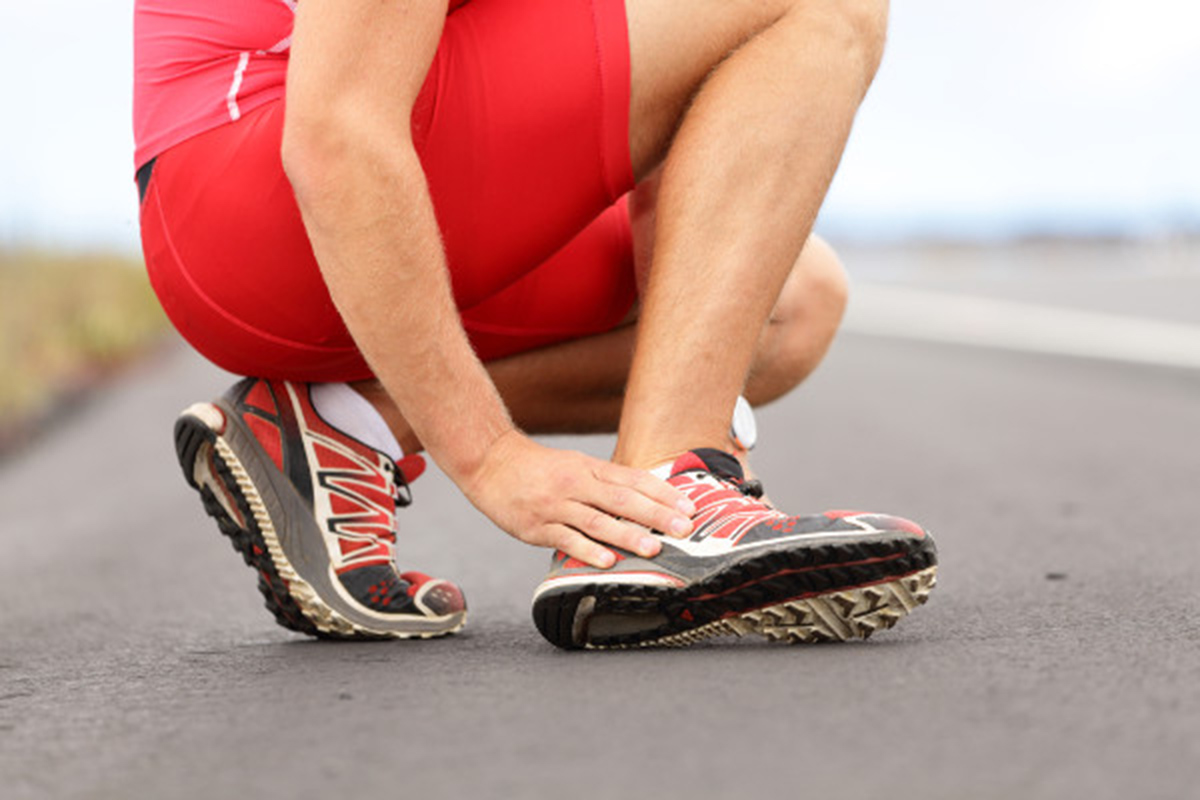There is nothing more upsetting to an athlete than running injuries. A slip on the ice, a turn of the ankle, or a chronic overuse injury can jeopardize weeks, months, and even years of training and fitness. Here are some simple ways you can avoid injury and stay sane.
Running Injuries
According to the Harvard Gazette, between 30 and 80 percent of all regular runners are injured in a given year. The American Academy of Physical Medicine and Rehabilitation narrows it down a bit more, reporting that nearly 70 percent of all runners will become injured. Let’s think about that for just a second. Seven out of every 10 runners are suffering from an injury on an annual basis. Chances are, if you’re a runner, you’ll be injured, too.
The most common running injuries are those caused by repetitive movements and stresses on the joints and tendons. You may recognize some of these more frustrating running injuries.
The Most Common Running Injuries
1. Runner’s Knee
The injury results in pain near the kneecap, especially after sitting for extended periods of time with knees bent or walking downstairs or downhill.
2. Iliotibial Band Syndrome
Pain or aching on the outside of the knee, usually occurring in the middle or at the end of a run.
3. Shin Splints
Pain occurring in either the front or inside portions of the lower leg.
4. Achilles Tendinitis
Pain begins as a mild ache in the back of the leg or above the heel after running.
5. Plantar Fasciitis
The pain is most noticeable when the foot flattens during weight-bearing or when pushing off with the toes during walking or running, and it is usually located near the heel.
Causes of Running Injury
There are two main causes of running injury: structural imbalance and training volume. Both can lead to injury, and many times the cause of the injury is not easy to diagnose. For example, a foot problem can cause a problem in the knees, hips, or back. Finding and treating the cause of a running injury is the job of a trained expert.
Structural imbalance occurs when the body is misaligned, or when a certain muscle group is weak and requires other muscle groups to compensate. Structural imbalances can be caused by physical attributes like uneven leg length or severe overpronation of the foot. These physical problems will cause running injury unless diagnosed and treated.
The body adapts to stresses and becomes stronger. This is the basic principle of training. But, if you push too fast or run too far, you can stress the body in such a way that it never has time to fully recover and weakens instead. Training progression and temperance are the keys to avoiding overuse injury. The following are other causes of running injuries.
Overload
These running injuries occur as a result of constantly repeating an action. As you walk, you always have one foot on the ground, which differs from running. Basically, running is a series of jumps where neither foot is on the ground. As a result, there are much greater stresses. Runners can lower the risk of injuries by ensuring they run on softer grounds. Additionally, they need to have appropriate footwear.
Failure to Recover
If you get foot injuries from running, always ensure you recover before you go for your next run. Your body incurs stress from running. When you give it time to recover, there are positive changes to your body. As a result, you become fitter and stronger.
However, if you do not allocate these stresses enough recovery time, your body can fail to recover. What follows is minor tissue damages which can become worse with subsequent training. So, before you hit the treadmill or go out for a run, ensure you have fully recovered to avoid these injuries.
Running Action Biomechanical Factors
How you run is extremely relevant. If you have watched people run, you may have concluded that some look incredible and others awful. However, how you look as you run may not necessarily contribute to running stresses, but they are linked.
Bowed legs, arched back, knock knees or flat feet are all factors that affect running efficiency and also your injury risk. Though gait and running style may be difficult to change, you can go for physical therapy for running injuries and consult a therapist.
Insufficient Nutrition
As you train, there is a depletion of muscle glycogen. Muscle glycogen is crucial in taking you through grueling exercises. When it’s depleted, it leads to fatigue and reduced performance. You can restore glycogen stores with nutrition by eating plenty of carbohydrates, pasta, potatoes, and rice.
If you fail to replenish these stores, you can start the next run on a deficit, leading to increased chance of injuries. Additionally, to avoid running back injuries, eating and drinking well is integral. Remember, water is also crucial for a runner.
Lack of Proper Preparation
Planning your training ensures you are healthy and fit enough to start and finish. If you feel tired or sick, you may evaluate if you should do that day’s session. It is crucial to adapt your plans accordingly. Additionally, you need to have appropriate clothing, footwear, and a conducive exercise surface.
As part of the running injury prevention checklist, you need to explore the training programs to find an effective one. Each runner responds differently to various programs. You can consider duration, intensity, type, and exercise frequency when choosing the right one. You need to achieve appropriate progression, allowing appropriate adaptation for strength and fitness gains. If you fail to do this, you can have increased chances of injury.
Inadequate Fitness
Often, especially in group training, colleagues can drag you into highly intense sessions, which may not be right for you. These can lead to overstrain, overuse, and cause inflammatory injuries. Always have a clear understanding of your current fitness and adapt the sessions to suit this state.
Prior Injury
After an injury, some runners may think it’s time to get back on track if they no longer feel pain. However, at this point, there is still a weakness, muscle imbalance, tightness, and other factors that they still need to consider. It is good to consult a physical therapist for muscle evaluation and motion analysis before resuming training.
5 Ways to Avoid Running Injury

1. Prepare your body for running by walking
If you’re a new runner or returning to running after a long hiatus, you’ll want to start slowly and condition your muscles with a regular walking program. Cross-training activities like swimming, rowing, or cycling will help with the cardiovascular aspect of running. But walking will strengthen the muscles, joints, and tendons where running injury often occurs.
2. Understand Your Body Type and Be Patient
For every pound of weight a person carries, they have four pounds on the knee when running. In other words, if you weigh 180 pounds, there are 720 pounds of force on the knee with each foot strike.
3. Follow a Sensible Training Plan or Find a Coach
Your training plan should consist mostly of easy days. The progression of a decent training plan accounts for rest in daily, weekly, and monthly cycles. Remember that a generic plan is nothing more than a good suggestion. You can, and should, deviate from the plan if your body sends you signals that something isn’t right. If you’re lucky enough to have a running coach, communicate openly about your concerns.
4. Wear the Right Shoes
There are all kinds of shoes out there. Find a pair that feels good on your feet and compliments your running style. Replace your shoes when they no longer feel good. Specialty running stores can help you find the right type of shoe but always ask about their return policy.
5. Practice Injury Prevention
Always warm up slowly for 10 minutes before running. Do some dynamic stretching before your runs and some static stretching after your runs. Foam roll tired muscles before and/or after runs. Ice and elevate any potential injury spots as soon as you feel them. Incorporate some strength training in your weekly routine to help strengthen your core and stabilize your body to prevent injury.
Steps to Take if You Get Running Injuries
You can take the following steps if you get injured:
- Stop running: Pushing through the pain only makes the injury worse
- See a doctor immediately for appropriate diagnosis and treatment
- Attend to soft tissue injuries such as muscle sprains and ligaments with lots of rest, icepacks, elevation, and compression
- Wait until the injury heals before running again. You can switch to low-impact training such as swimming to avoid aggravating the injury.
- Consult with your doctor or physical therapist before resuming running.
- Engage a physical therapist for gait training, strength and flexibility exercises. They can also advise you on how to avoid running injuries.
Seek the advice of medical professionals before your injury stops you from running. And, most importantly, listen to your body and recognize the signs of overtraining so that you can avoid running injury.




